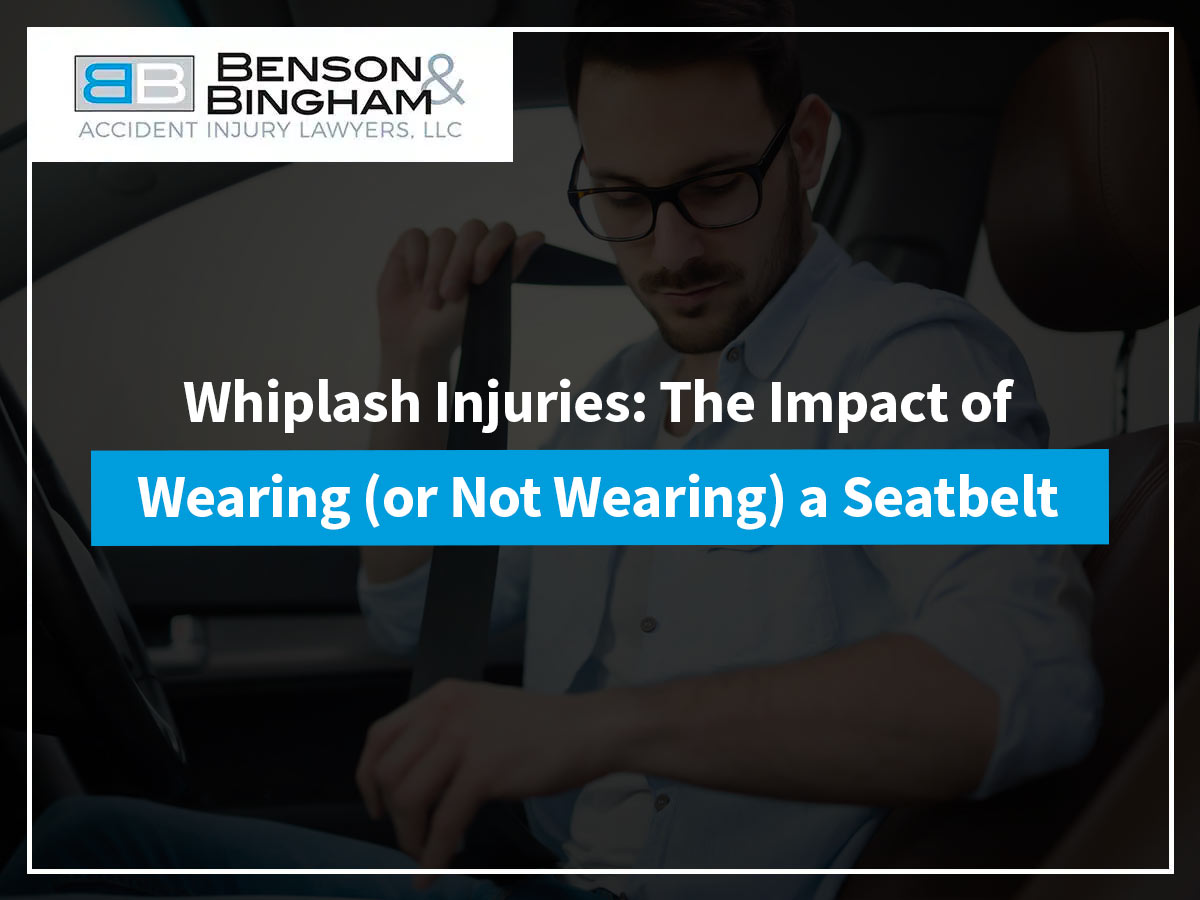
Understanding Whiplash & Its Causes
Whiplash is a common neck injury that occurs when the head is suddenly forced backward and then forward, causing a rapid strain on the neck’s muscles and ligaments. These injuries are often caused by rear-end accidents, but they can result from any type of vehicle impact, such as side collisions or head-on crashes. While wearing a seatbelt certainly prevents many severe injuries from happening, individuals can still sustain whiplash even if they do wear their seat belts appropriately. Let’s explore how seatbelt use affects the risk and severity of whiplash and what it means for your health and legal claims.
What Happens During a Whiplash Injury?
During a car crash, the sudden deceleration of the vehicle creates a force that propels the body forward. When wearing a seatbelt, the torso is held in place, but the head and neck may continue to move, causing a rapid extension and flexion of the neck. This movement strains the soft tissues, leading to:
- Neck and Shoulder Pain: A common early symptom due to muscle strain.
- Headaches: Often starting at the base of the skull, they may persist for days or weeks.
- Limited Range of Motion: Stiffness in the neck and upper back, making it difficult to turn the head.
- Nerve Irritation: Severe cases may involve nerve compression, leading to tingling or numbness in the arms.
How Seatbelts Reduce Whiplash Risk
Seatbelts are designed to secure the body during a collision, reducing the movement of the torso and minimizing injury risks. Here’s how they contribute to mitigating whiplash:
- Restraining Upper Body Movement: Seatbelts prevent the upper body from being thrown forward, reducing the range of motion that can stress the neck.
- Complementing Airbags: In conjunction with airbags, seatbelts help slow down the forward movement of the head, offering a cushioning effect that further reduces impact on the neck.
- Improving Overall Crash Survival: While seatbelts might not eliminate whiplash completely, they significantly decrease the likelihood of other serious injuries, like traumatic brain injuries or internal damage.
Can You Get Whiplash Even with a Seatbelt?
Yes, even with proper seatbelt use, whiplash can still occur. The neck’s delicate structures, such as muscles and ligaments, can be strained from the rapid movement during impact, regardless of the restraint provided by the seatbelt. The force from a rear-end collision, even at lower speeds, can be enough to cause these injuries. However, the seatbelt’s restraint ensures that the injury is less severe compared to those who are unrestrained, as it reduces the overall movement of the body during the crash.

Consequences of Not Wearing a Seatbelt in Car Accidents
Failing to wear a seatbelt increases the severity of whiplash and the risk of additional injuries during an accident:
- Greater Head Movement: Without a seatbelt, the body moves more freely, allowing the head and neck to experience more forceful motion, which can lead to a more serious whiplash injury.
- Risk of Being Ejected: In high-speed crashes, the absence of a seatbelt can result in being ejected from the vehicle, which can cause life-threatening injuries.
- Higher Chance of Secondary Impacts: Unrestrained passengers can collide with the interior of the vehicle (e.g., the dashboard, steering wheel, or windshield), which can worsen whiplash symptoms and lead to additional injuries like facial trauma or broken ribs.
The Legal Impact of Seatbelt Use in Whiplash Claims
Seatbelt use can have significant implications when filing a personal injury claim after a car accident in Nevada. Here’s how:
- Comparative Negligence Laws: Nevada operates under a modified comparative negligence rule. This means that if it’s determined that not wearing a seatbelt contributed to the severity of your injuries, your compensation could be reduced proportionally. For example, if you’re deemed 20% responsible for your injuries because you were not wearing a seatbelt, your compensation could be reduced by 20%.
- Building a Strong Case with Legal Support: Even if a seatbelt was not used, experienced Las Vegas car accident attorneys can help build a strong case by demonstrating how the accident caused the injuries. This may involve gathering medical records, accident reports, and expert testimony to ensure fair compensation.
How Long Does Whiplash Take to Heal?
The recovery time for whiplash varies based on the severity of the injury and the treatment approach. Typically:
- Mild Whiplash: Symptoms may resolve within 2-4 weeks with rest, gentle stretching, and over-the-counter pain relievers.
- Moderate Whiplash: Physical therapy and chiropractic care may be required, extending recovery time to 6-12 weeks.
- Severe Whiplash: Deep tissue damage, ligament injuries, or nerve involvement can require several months of rehabilitation, including advanced pain management techniques and possible specialist intervention.
Long-Term Effects of Severe Whiplash
In some cases, whiplash can have long-term effects, particularly if the injury is not addressed promptly. These effects may include:
- Chronic Neck Pain: Persistent pain that requires ongoing management, such as physical therapy or medication.
- Reduced Range of Motion: Difficulty turning or tilting the head, which can affect daily activities.
- Headaches and Dizziness: Lingering symptoms that can impact concentration and quality of life.
- Psychological Impacts: Chronic pain from severe whiplash can contribute to anxiety, depression, and difficulty sleeping.
Tips for Preventing Whiplash
While you cannot eliminate the risk of whiplash entirely, you can take steps to minimize its severity:
- Always Wear Your Seatbelt: Ensuring that all passengers are properly restrained reduces the risk of severe injuries.
- Adjust Your Headrest: Position the headrest so that the top is level with the top of your head and as close to the back of your head as possible to reduce the backward movement during a collision.
- Drive Defensively: Avoid tailgating and remain aware of vehicles behind you to reduce the likelihood of being involved in a rear-end collision.
Safety, Recovery & Legal Support
Wearing a seatbelt is one of the simplest ways to reduce the risk of severe whiplash and other injuries during a car accident. Even with a seatbelt, though, whiplash can still occur, making it essential to seek prompt medical treatment and professional legal support.
This article is brought to you by Southern Nevada Chiropractic, a Nevada-based clinic focused on providing comprehensive care and support for car accident victims
Northeast Vegas
4800 E. Bonanza Rd #2, Las Vegas, NV 89110
North Las Vegas
1527 W. Craig Rd #8, NLV, NV 89032
North West Vegas
7280 W. Azure Dr #130, Las Vegas, NV 89130
Green Valley
1701 N. Green Valley Pkwy, Bldg 8-A, Henderson, NV 89074
South West Vegas
9670 W. Tropicana #110, Las Vegas, NV 89147
Central Vegas
4750 W. Sahara Ave #28 Las Vegas, NV 89102


